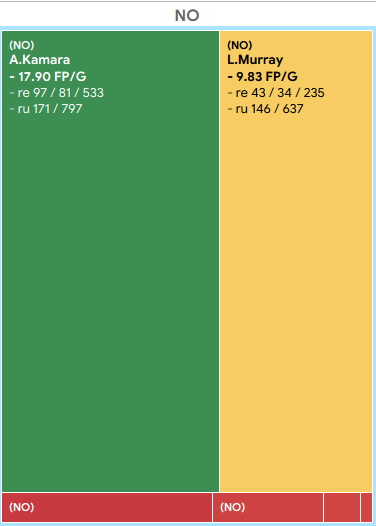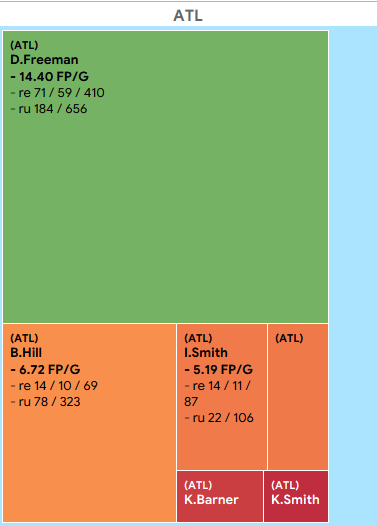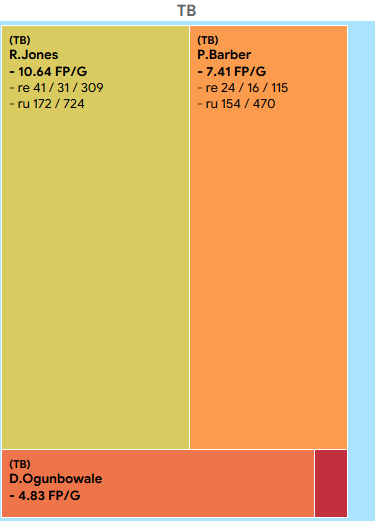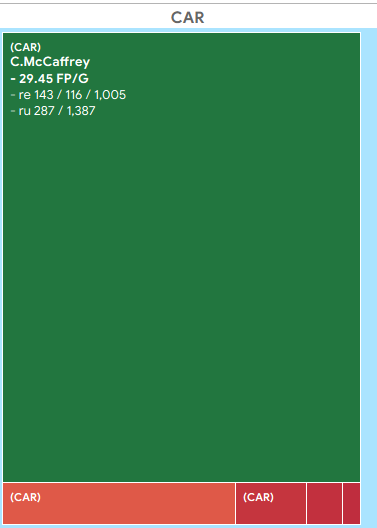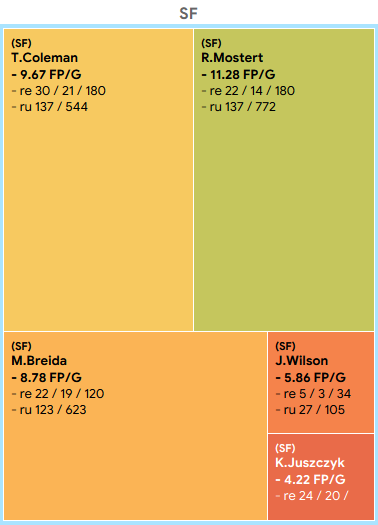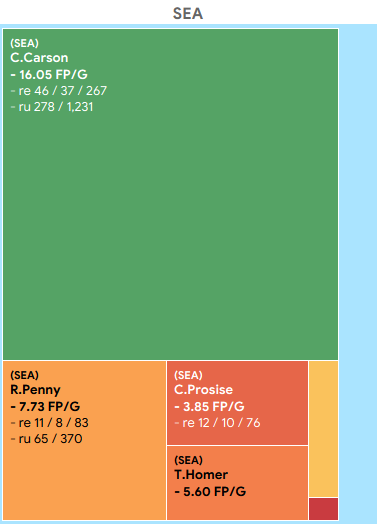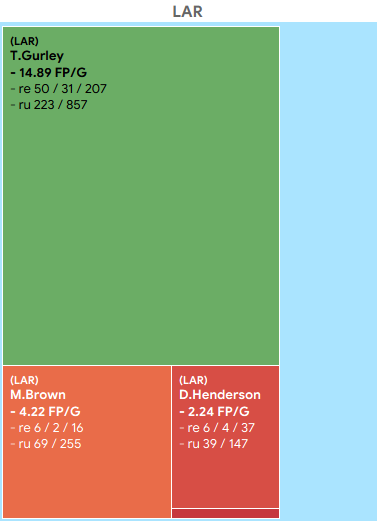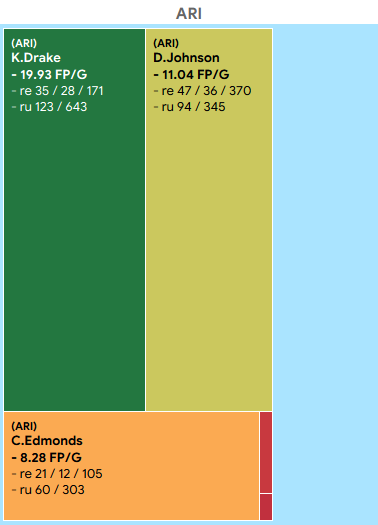Antonio Losada looks at last season's running back usage and fantasy impact for each of the 32 NFL teams. He tackles both the NFC South and NFC West franchises this time around.
We roll on with coverage of each of the eight NFL divisions, discussing the teams that are part of them and the running backs that were part of those teams in 2019. To present those teams and players I use a set of easy-to-read charts: treemaps. The graphics will hold all of the players of each team, the size of each box corresponding with the number of targets+carries (percentage among teammates) he saw during the season and the color related to the fantasy points per game (PPR-format leagues) he finished with at the end of the year. Also, the width of the full graphic represents how many total opportunities (tarets+carries; combining those of every rusher) were awarded to running backs by the team compared to the rest of the teams of its division (the empty space in blue to the right, the fewer targets+carries were used by rushers of such team).
Just to make things as clear as possible, I will add a little personal blurb on each team and how they performed in terms of RB usage and impact during the 2019 season. Let's dive in, this time covering the NFC South and NFC West.
Check out the other parts of this series, broken up by divisional pairs: AFC South & West, NFC East & North.
Featured Promo: New Novig users get a $25 purchase match (50% discount up to $25) on your first Novig deposit, and 3 free months of RotoBaller's "Big-4" Premium Pass (NFL, NBA, MLB, NHL) which includes exclusive tools for Betting, Props, DFS and more! CLAIM IT NOW
- New Orleans Saints
- As expected, Alvin Kamara was the leading man in New Orleans' backfield, logging more than half (56%) of the opportunities himself. He was also the most productive, returning 55% of the total fantasy points.
- Perhaps more surprising was Latavius Murray's efficiency. Given just 37.7% of the opportunities (most of them due to Kamara missing time), he was able to rack up 39.3% of the Saints backfield FP.
- Atlanta Falcons
- Devonta Freeman finished the year as the clear best rusher of the Falcons. He used 57.7% of the opportunities and gave 53.8% of the total fantasy points back himself, but missed two games in the second half of the season and never reached 100 yards in any game. Still, he'll be looking for a new home in 2020.
- Although Brian Hill saw 22.1% of the opportunities and returned 19.8% of the team's points, it was Ito Smith on just 9.9% usage who surprised the most getting 12.3% of the backfield's point to his name on a very limited number of chances. I'm very intrigued to see where things go for him next season.
- Tampa Bay Buccanneers
- A nightmare of a backfield like not many others. Jones and Barber built an RBBC-system in Tampa Bay logging 45.3% and 40.5% of the opportunities respectively and returning 42.3% and 34.5% of the points each. It was a pretty interchangeable backfield that might work in real life but does little good in fantasy leagues.
- Just to add fuel to the fire, Dare Ogunbowale also was thrown into the mix and even on a low 12.7% of the total opportunities, he returned a massive 21.8% of the team's points. Let's hope this doesn't turn into a three-in-one package or we'd need to say goodbye to Bucs RBs in 2020.
- Carolina Panthers
- Christian McCaffrey, that's all I need to say.
- CMC with 92.3% of opportunities and 92.8% of the points to his name, rightfully so. A beautiful sight to behold.
- San Francisco 49ers
- Tampa Bay's backfield 2.0 (see Bucs notes above).
- Not a perfect alignment in terms of usage/production, but for the most part, it worked. If we judge by point share then it should have actually been Mostert RB1, Coleman RB2, and Breida RB3.
- Even looking at the rushing/receiving splits, it was super close with no one tasked with just one part of the game. Everybody ate, everybody thrived, and fantasy football owners were screwed deciding who to play each week.
- Seattle Seahawks
- It seemed like Penny could find a place in this backfield but ultimately it was all about Chris Carson, who finished the year seeing 73.9% of the team's opportunities and giving back 67.4% of the points.
- Penny wasn't bad, but his low usage rate (17.8%) cut his production too short and left him at Prosise's level hadn't it been for the former's valuable (but often unpredictable) touchdowns.
- Los Angeles Rams
- Healthy or not, Gurley led the Rams backfield with his 68.2% opportunity share. It made sense, considering he averaged 15.1 points per game while no other tailback averaged more than four...
- I still think this should have ended in a much greater split with Gurley at the head. The rest of the rushing corps were just too bad to keep feeding them on a drive-by-drive basis.
- Arizona Cardinals
- Even playing just six games for the Cardinals, Drake was still able to rack up 32.4% of the team's total points in the year on 33.9% of the opportunities.
- David Johnson's days as a league-winner might be over. He had 41.1% and 32.2% opportunity and point shares but his 11.8 FP/G were too bad to be considered a top-tier RB1.
- Chase Edmonds, on a much more limited usage (23.8%) gave back 27.7% of the team's points. Put together Drake and Edmonds on a healthier diet of opportunities and Johnson has no place in this backfield going forward, assuming he isn't released.
More Fantasy Football Analysis





 RADIO
RADIO








